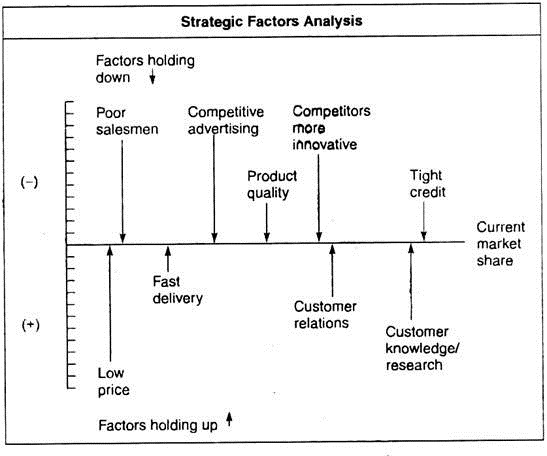In this article we will discuss about the analysis of strategic factors used for making useful strategic identification which is needed for the success of a company.
Strategic factors are those key issues that are strategically relevant and that will determine the success of any company in a particular industry and at a given stage in its life cycle. The economics, technology, and socio-political setting of the industry determine what they are.
The managers can narrow the range of strategy identification by asking themselves what are the handful of strategic factors determining the success of their firm in their particular environment and then identifying those strategies capable of meeting the requirement.
In this process, managers should do ‘corporate appraisal’ to take a balanced view of strengths and weaknesses of each and every factor.
This is illustrated below:
The horizontal line represents the current state of something—anything—that is to be considered. Examples are current market share, present profitability, etc. The vertical lines above and below the horizontal line represent the factors that have been identified as strategic.
Arrows can be drawn from each strategic (key) item identified, using the scale to provide a judgmental view of the importance of the factor. Longer lines are more important than short lines. Finally, it is necessary to identify what issues can and should be addressed to remove negative factors or strengthen positive ones. This simple approach is very effective in achieving balance and consensus.
This scheme of ‘corporate appraisal’ used in identifying strategic factors should not be seen as being completely isolated from the studies of the environment. There are interrelationships, and although the two stages are conceptually separate, each impinges on the other.
Thus the first appreciation of the appraisal should be modified by what is learnt about environmental trends and expectations. Market share and the performance of competitors are but two examples of external factors which properly form part of the corporate appraisal. There is no hard and fast line where it is possible to say that the corporate appraisal ends and environmental trends begin.
What factors should be considered in the appraisal? The answer will vary between organisations, and although a generalised view can be given, a real situation will call for some critical situation.
A number of following basic concepts should be carried in mind as the appraisal progresses, and performance rated against them:
1. There might be a better way of doing anything until the contrary is proved;
2. Often knowledge of what is being done is not as perfect as managers within a company believe;
3. When ‘what’ is being done has been established, the question ‘why’ should be asked; and
4. The future is more important than the present, where the trends and effects on the aspects studied can be foreseen.
